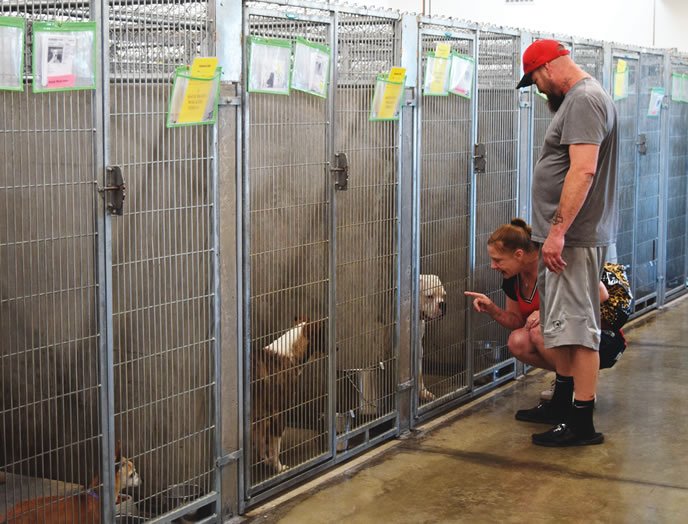[Updated August 24, 2018]
For the first time in several decades, my husband and I are actively seeking a dog to adopt. With our family pack at a long-time low of three dogs, all seniors, it’s time to add a younger set of paws, but now that neither of us works at a shelter, it’s not as easy to trip over a dog who speaks to our hearts. We now find ourselves having to actively look for one – a unique position for us, but one in which most normal, non-shelter/rescue humans are quite likely to find themselves. Having experienced in recent years an exponential increase in clients who adopted inappropriate dogs with significant problem behaviors – dogs who should never have been released by the shelter or rescue group – I know all too well how rocky the path to adoption can be these days. So, we’re taking the advice we’d give to anyone else in our situation in order to prevent a regrettable adoption.

Yes, sometimes adoptions are bad – either for the humans, the dogs, or both. Over the past few years, I’ve seen a veritable parade of clients at my training center for consults regarding adopted dogs whose behavioral baggage was much bigger than their adopters had anticipated. Some clients worked through or learned how to live with their dogs’ difficult behaviors. Others have decided the issues were more than they could handle, and returned or even euthanized their dogs.
Bad adoptions can traumatize entire families and cost everyone involved a lot of time and even money, especially when veterinary and/or behavioral consultations are needed. The stakes are very high! Here are some examples of some difficult adoptions made by people who consulted me afterward for help with their new dogs (names have been changed):
Archie – An adult, neutered Labrador Retriever, Archie was adopted from a local Labrador rescue group by the owner of a construction company. Mark had owned Labs before, and wanted another dog who would ride well in his truck, one that he could take to work with him on construction sites and who could be his constant companion. Instead, he unknowingly adopted a dog with a prior bite history (rescue failed to inform him) who had been returned to rescue after at least three previous adoptions due to his aggressive behavior, who fiercely guarded resources, and who became so aroused by outside stimuli when riding in a vehicle that he would bite his new owner.
After our very sobering initial consult, Mark made the commitment to Archie to do everything he could to make it work. Mark assiduously implemented the protocols we agreed on, and despite being bitten several times, has made it work. He started leaving Archie home instead of taking him to construction sites, and then had to work through some mild isolation anxiety. He implemented counter-conditioning and desensitization protocols for Archie’s resource-guarding and handling issues. Most important: He came to understand that Archie was acting defensively, not maliciously, and was able to stop taking personal offense at Archie’s behavior. Archie has a home for life and Mark loves him dearly.
Maggie – A 7-month-old spayed Tibetan Terrier, Maggie was purchased from a breeder two weeks prior. Her new owner Carol had been my client years earlier with another dog, and she had done an outstanding job modifying that dog’s dog-reactive behavior. The two of them had enjoyed a full life together, and a year after she lost that dog to old age, she was finally ready for a new dog.
Maggie was a little shy at the breeder’s, but when Carol brought her home she discovered that Maggie was terrified of almost everything. The breeder clearly had not done an adequate job of socializing this pup, a problem compounded by the fact that the breeder kept her until she was more than six months old without appropriate exposure to normal real-world stimuli.
Carol made a valiant effort to decrease Maggie’s fearfulness using counter-conditioning, desensitization, and confidence-building exercises (such as those seen in “Be Brave,” WDJ September 2011), but ultimately decided the two of them would never have a fulfilling life together. With my support, she returned Maggie to the breeder, who tried to blame her for the dog’s behavior (I had warned her this might happen). Finally, the breeder did take Maggie back (and did not refund her purchase price).

Rex – A 2-year-old neutered male Rhodesian Ridgeback, Rex was recently adopted (sight unseen) from a Ridgeback rescue group on the other side of the country. His new owners, Jane and Bill, discovered that he was extremely shy, fearful of noises, humans, and other dogs – and in fact, was already on medication (fluoxetine) for his fearfulness.
Unfortunately, this was not at all what they had told the rescue coordinator they were looking for! They had wanted to adopt a dog who would play with their other Ridgeback, Trixie, a vigorous canine play pal. They had described Trixie’s personality to the coordinator, who promised them that Rex was a perfect match. That was clearly not the case.
At the conclusion of our consult, Jane and Bill made it clear they were committed to keeping Rex despite the time-consuming fear-alleviating protocols we discussed, and knowing he may never be the playmate they wanted for Trixie. Recent communication with them determined that his fear of noises and humans is improving, but very slowly. He still does not play with other dogs.
Adopter Beware
These are just a few of the many similar cases in my file cabinets. I wasn’t able to help these clients avoid the pitfalls of adopting dogs who were behaviorally damaged, but perhaps I can help you.
Here are five things you can do to maximize your chances of adopting a dog who will turn out to be all you want him to be:
1. Be willing to wait. Just because you are at the shelter or rescue facility doesn’t mean you have to go home with a dog that day. Staff or volunteers may pressure you to adopt a dog, perhaps even telling you the dog will be euthanized for space if you don’t take him home.
Remember that you, too, have limited space; most of us have space for just a few dogs in our families and lives, and with luck, the dog you adopt will be with you for 10 to 15 or more years. Resist the pressure and the sad eyes, unless the dog you truly want is there that day. You can always come back, and keep coming back, until the dog of your dreams is there.
2. Meet the dog before you adopt. Internet adoptions are all the rage these days, and any good training and behavior professional will tell you “Don’t do it!” Regardless of the descriptions and assurances someone may give you, you have no idea who you are adopting unless you meet him first. If you must adopt a dog from across the country because you fell in love with him on Petfinder or some other website, fly out to meet him, and if he turns out to be your Prince Charming, rent a car and drive him back home.
3. Let your head rule your heart. It’s all too easy to feel sorry for the poor, frightened dog huddling in the corner of her kennel at the shelter. Your heart says, “Oh, I have to help him. If I take him home and love him enough, he’ll turn into a wonderful dog and he will love me for saving him.”
While it’s true that there are some dogs who find the kennel environment overwhelming and are just great outside the shelter, other dogs who behave like this in the shelter may actually be like this eveywhere they are taken.
Ask if you can take the dog outside, or to a room far away from the kennel noise. If he morphs into a friendly, happy, normal dog when you get him away from the kennels, then you’re on more solid ground; you probably have a reasonably normal dog who is on the sensitive side and cannot handle kennel chaos. Even so, keep in mind that he may also be fearful of other busy or chaotic environments.
If, instead, he continues to be fearful outside of the kennels, he may be a pathologically fearful dog who will take tons of work and still may never be even close to normal. Your head should say, “Not for me.” Listen!
4. Ask for a behavior assessment. Many reputable shelter and rescue groups have some sort of process by which they identify various behaviors and characteristics of the dogs they make available for adoption. While these are not necessarily scientifically validated, they can give you more information than you might gain by simply looking at the dog. If the dog has been in a foster home, good foster parents will have notes about his behavior while in their care. If the organization does assessments, or has other behavior information about the dog, they should be happy and willing to share it with you.
An important note: Make sure your own observations are congruent with the information the shelter or rescue group provides. If they tell you the dog hiding under the chair is confident, bold, and outgoing, something is amiss.
5. Engage a professional to help you find a dog. Many dog-training and behavior professionals offer adoption-counseling services. Very few future dog owners take advantage of those services. If you are not confident about your ability to choose wisely, you might benefit from professional assistance.
Adopting Troubled Dogs vs. Easier Dogs
Shelters, rescue groups, and breeders are all implicated in the litany of sad cases that make up my files these days. They all sadden me, but the ones I find particularly tragic are the dogs adopted from shelters and rescues – organizations dedicated to the well-being of the animals in their care. These are dogs who have already failed in at least one home, and their caretakers have an obligation to set them up for the best chance for success in their next one.
I know that I see a skewed population – very few successful adoptions come to me for behavior consults; mostly, I see only the troubled ones. I do know that shelters and rescuers often do an exemplary job of placing great dogs in appropriate homes, and dogs with some behavioral challenges in fully informed homes that are well-equipped to work with them. I also know that there are breeders who do a terrific job of socializing their puppies.
Still, I see many dogs who would have never been made available for adoption during the two decades that I worked in a shelter (1976-1996) and who shouldn’t have been placed in homes today. I understand and applaud legitimate, responsible efforts to reduce euthanasia numbers. Placing badly damaged dogs is neither legitimate nor responsible, and even the “no-kill” movement allows for euthanasia of dogs who are “non-treatable and non-rehabilitatable.”
Those groups who want to save dogs with significant behavioral issues need to be willing to invest the necessary resources to effectively modify the dogs’ behavior before they are placed in homes, and many do. An increasing number of shelters are hiring behavior specialists and even adding entire behavior departments to their organizational structures. And many rescue groups have relationships with behavior professionals to assist them with difficult dogs. I am happy to work with several rescue groups (at a significant discount on my rates) and love the dedication that I see in these groups’ staff and volunteers. We cry together on those rare occasions when we agree that one of their charges is beyond our help.
There are still plenty of reasonably well-behaved, behaviorally sound dogs who are being euthanized for lack of homes – dogs who, with a little effort, can be as perfect as you could want a dog to be. Why not look for one of them the next time there is room in your home and your heart for another canine family member?
Pat Miller, CBCC-KA, CPDT-KA, is WDJ’s Training Editor. She lives in Fairplay, Maryland, site of her Peaceable Paws training center, where she offers dog-training classes and courses for trainers. Pat is also the author of many books on positive training, including, Do Over Dogs: Give Your Dog a Second Chance at a First-Class Life, and, How to Foster Dogs; From Homeless to Homeward Bound.







Thank you for shining a light on this problem. I adopted a dog who the SPCA said would be easy and she was anything but. I ended up with a project that has been time and money consuming. I kept my dog, she’s doing a lot better, and I learned a lot. But it disrupted my life and the time/money consuming project wasn’t my preference.
I live in a big city and was committed to getting dog from SPCA or municipal shelter. They’re understaffed and at the least, I should have taken the dog for a walk (something I needed a dog to be able to do). I would have seen that she was leash reactive, and this would have given me pause.
It’s sad that dogs are mistreated and/or neglected and have consequent behavioral issues, but not everyone is in a position to rehabilitate a dog. The best case is finding a better match. Fenced in yards give flexibility to handling behavioral issues.
Thank you for shining a light on this problem. I adopted a dog who the SPCA said would be easy and she was anything but. I ended up with a project that has been time and money consuming. I kept my dog, she’s doing a lot better, and I learned a lot. But it disrupted my life and the time/money consuming project wasn’t my preference.
I live in a big city and was committed to getting dog from SPCA or municipal shelter. They’re understaffed and at the least, I should have taken the dog for a walk (something I needed a dog to be able to do). I would have seen that she was leash reactive, and this would have given me pause.
It’s sad that dogs are mistreated and/or neglected and have consequent behavioral issues, but not everyone is in a position to rehabilitate a dog. The best case is finding a better match. Fenced in yards give flexibility to handling behavioral issues. Also being at home a lot.
I have ‘rehomed’ teo dogs.
One acquired as a pup. She had problems but when she wnr for my uoung somn’s friends face I decided enough was enough. The RAAF took her and wondered why I wanted to surrender a such a good dog.\Tne other was my daughter’s do who was introuble for barking and escaping n suburbia, I loved him , but he began challeinig the very larg male Germa Shepherd for dominance. Fletch was a patient dog but only ONE bite would have been fatal, When I heard of someone very much wanting as good entire male Mini-foxie I passed him on.
Only one I surrendered to the RSPCA. Taken on as a Kelpie — she wasn’t –her behaviour was pure terrier and she was biting the bigger dogs’ heels the whole time. Once again I decided to rehome her before she was killed 🙁 Well DH insisted! I HOPE she found a home — she would have been a lovely ‘only dog’.
Now I have “The Speagle” Mad Millie. Not what I wanted but I minded her and she decided she wanted to stay. Hid when my Sister came back to colect her (eventually) > she came with problems — mostly run away and kennelosos. Butb we’ve learned to love this funny little creature. Very very different from any other dog I’ve ever had.